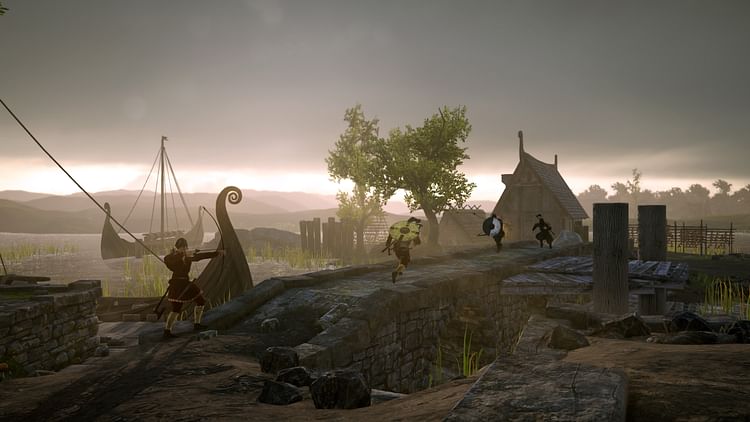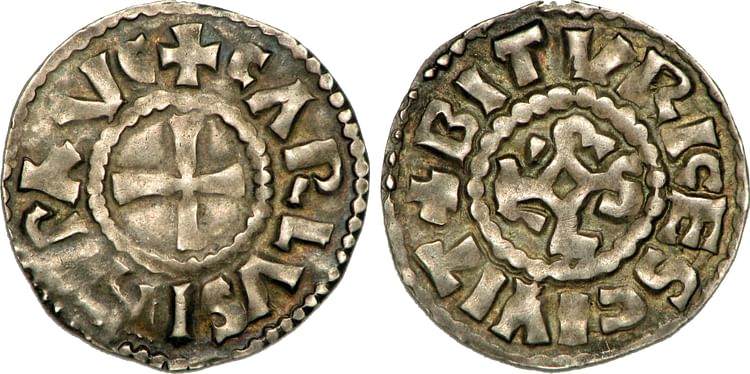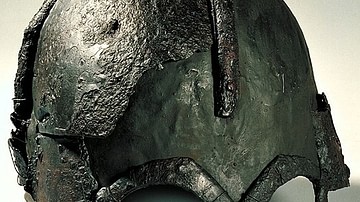
Charles the Simple (Charles III of France, l. 879-929, r. 893-923) was king of West Francia (roughly modern-day France) toward the end of the period of Viking raids in the region. His epithet `the simple' refers to his habit of being straightforward and honest, not simple-minded or slow. He is featured in the TV series Vikings where his character is played by Canadian actor Lothaire Bluteau.
Although Charles was not a brilliant tactician and did not wield the kind of personal power of his predecessors, he was insightful and maintained a clear enough vision of West Francia's position to enable him to broker a unique contract with the Viking chief Rollo (later known as Rollo of Normandy, r. 911-927) which secured the kingdom from future Viking raids; the event for which he is best remembered. The pact between Charles and Rollo stabilized the kingdom and provided for the peace and security necessary for the region's development and growth.
The cooperation and consideration shown between the Viking chief and the Frankish king was unique at the time, benefiting both of the peoples under their reign and the region at large. Their contract lay the foundation for the kind of stability necessary for the later king Hugh Capet (r. 987-996) to found the Kingdom of France, precursor to the modern-day nation.
Early Life & Viking Raids
Charles was born in 879, the son of Louis the Stammerer (r. 877-879) and his second wife, Adelaide of Paris (c. 850-901). Louis had secretly married Ansgarde of Burgundy (d. c. 880) with whom he had two sons - the future Louis III (r. 879-882) and Carloman II (r.879-884) - but his father (Charles the Bald, r. 843-877) had already arranged for him to marry Adelaide and so had Louis' marriage to Ansgarde annulled.
When Louis died in 879, Ansgarde advanced her two sons as the next in line to rule but when Adelaide gave birth to Charles the Simple a few months after Louis' death, he became the legitimate heir. Ansgarde, however, charged Adelaide with adultery under the precepts of the church and, with their backing, placed her sons on the throne as co-rulers late in 879.

Charles grew up during the latter part of the Viking raids on West Francia which had been ongoing since 820. The emperor Charlemagne (r.800-814) had maintained tight control of his region throughout his reign but, after his death, the Vikings began making incursions up the Seine to raid at will. Under Charlemagne's successor Louis I (Louis the Pious, 814-840), the Vikings were placated through bribes and favors but, when Louis died, his three sons plunged the region into civil war in a conflict over succession which was resolved in 843 by the Treaty of Verdun.
The former empire of Charlemagne and Louis I was divided between Louis the German (r. 843-876) who took East Francia (later Germany), Lothair (r. 843-855), Middle Francia (later the site of the Kingdom of Lotharingia and, later still, the Alsace-Lorraine region), while Charles the Bald took West Francia. The animosity between the three brothers would mean that, when the Vikings came, none of them could expect any help from the others.
The first Viking foray of 820 was easily turned back because the Vikings were unprepared for the defense mounted by the Frankish shore guard but the next time they came, in 841 (one year after Louis I's death) they plundered the region around Rouen and burned the city. This raid was led by the Viking chief Asgeir and was so successful it encouraged the 845 Siege of Paris by the Norse chieftain Reginherus (one of the possible inspirations for the legendary character Ragnar Lothbrok).
Reginherus' siege was lifted only when Charles the Bald agreed to pay the Viking chief 7,000 pounds in gold and silver. This is the first recorded instance of a monarch paying the Vikings for peace (a practice later known as a Danegeld payment in England) and would increasingly come to be relied on by Charles the Bald and his successors.
In 851-852 Asgeir returned and raided the land from a base established at Rouen. He was either replaced as chief or shared leadership with another named Godfrid who negotiated with Charles the Bald and, apparently, was paid to call off his raids and return home. In c. 858, Charles the Bald was again forced to pay off the Vikings when Bjorn Ironside and Hastein (also known as Hasting) captured the monasteries of Paris and held them ransom. By 860, Charles the Bald was paying a Viking chief named Veland 3,000 pounds of silver to fight other Viking bands on his behalf because his own resources were not up to the task.
The Viking raids were not so much a threat to the government of West Francia as they were a destabilizing force. Scholar Janet L. Nelson notes, “In terms of economic geography, the Seine basin constituted the heartland of the West Frankish kingdom of Charles the Bald. A 9th century writer (a local man) called it Charles' paradise” (Sawyer, 30). Charles found it nearly impossible, however, to protect this `paradise' prior to 866 when he had fortified bridges built and channeled more effort toward preventing Vikings from making shore but, even so, these efforts were simply not enough. He was forced, therefore, to continue the policy of appeasement in paying the Vikings off, as in the instance of the 876 raid when he paid a Viking band, which most likely included Rollo, 5,000 pounds of silver to leave the region.
The Siege of Paris 885-886
Charles the Bald died in 877 and defense of the realm fell to Louis the Stammerer and then his two sons Louis III and Carloman II. Louis the Stammerer died campaigning ineffectually against the Vikings while Louis III, even though winning a great victory in 881, could do nothing to stop the raids; Carloman II was less successful. When Carloman II died without an heir, the nobility of West Francia invited Charles the Fat of East Francia (Louis the German's youngest son) to reign and he took the throne in 884.
Charles the Simple was six years old when the Vikings returned in 885 to lay siege to Paris. Charles the Fat was occupied with his own problems in East Francia at the time and defense of the city fell to Odo, Count of Paris (later King of West Francia 888-898). Odo held the city against repeated assaults while also dealing with an outbreak of disease in the city for over a year before Charles the Fat arrived with his army in response to the city's appeal for help. Rather than engage the Vikings in battle, however, Charles the Fat paid them to leave and offered the helpful suggestion that they go raid Burgundy instead.
Although Charles the Fat's solution to the problem alleviated the siege, it was considered dishonorable by the nobility who deposed him in 888 and elected Odo as king. Odo reigned effectively for the next ten years but, as he was not a legitimate heir to Charles the Bald and the Kingdom of West Francia, the nobility advocated the advancement of Charles the Simple once he came of age. Odo resisted their pressure, while steadily losing power and influence. Charles was crowned king in 893 but had no real power until Odo died in 898.
Charles & Rollo
Charles was 19 years old when he came to the throne and inherited the same problem which had plagued his predecessors. Rollo had remained in the region after the siege of Paris ended in 886 and raided the land at will, carrying off captives for the slave trade or ransoming them back to families who could pay, as well as taking whatever valuables he found at hand.
The nobility appealed to Charles to do something about Rollo's raiders and, according to the historian Dudo (10th century), suggested that he offer the Viking chief land, title, and his daughter in marriage in exchange for peace and protection. Rather than continue the futile contest with the Vikings, or resort to the earlier precedent of paying them to leave or hiring them as mercenaries, Charles the Simple agreed with the nobles' plan and made the offer, which Rollo accepted. Scholar C. Warren Hollister writes:
In 911 King Charles the Simple created a friendly Viking buffer state in northern France by concluding an epoch-making treaty with a Norse chieftain named Rollo. The Vikings in Rollo's band had been conducting raids from their settlement at the mouth of the Seine River. Charles, less simple than his name would imply, determined that if he could make Rollo his ally, the Seine settlement might well prove an effective barrier against further raids. Rollo became a Christian, married Charles the Simple's daughter, and recognized – at least in some sense – the superiority of the West Frankish monarchy. Thus Rollo's state acquired legitimacy in the eyes of Western Christendom. (123)
The land Rollo acquired became Normandy and, true to his word, he protected his region and West Francia from further Viking incursions. After the treaty of 911, there are no more Viking raids up the Seine recorded.
Lotharingia & the Struggle for the Crown
That same year, the king of Lotharingia in East Francia, Louis the Child (r.900-911), died and his people asked Charles to become their king. Charles had been eager to merge Lotharingia with his own realm and had married the Lotharingian noblewoman Frederuna in 907 to further this goal. At some point after their marriage, Frederuna brought her relative to the West Francia court (possibly an uncle), Count Hagano, who became one of Charles' counselors and, in time, his favorite. Frederuna died in 917, having given Charles six daughters but no sons, and he then married Eadgifu of Wessex (902-955) in 919.
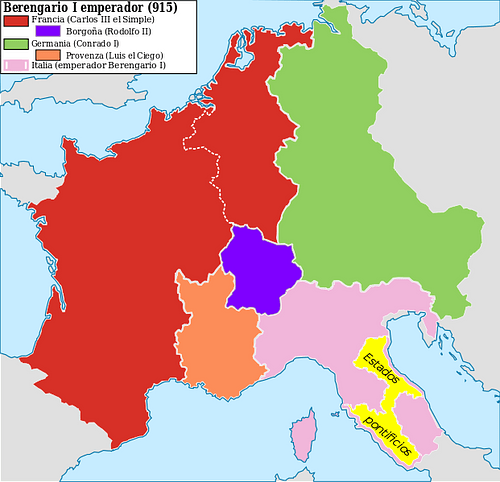
His marriage to Eadgifu was not only in the interests of fathering a male heir but also for her political connections. Eadgifu was a daughter of Edward the Elder (r. 899-924) of Wessex, the son and successor of Alfred the Great (r. 871-899). She was also the niece of Aethelflaed, Lady of the Mercians (r. 911-918), Alfred's daughter, with connections to the Kingdom of Mercia which was now controlled by Edward following Aethelflaed's death. Charles' marriage to Eadgifu, therefore, united him with a powerful dynasty in England which should have proved beneficial to him.
Unfortunately, Charles' almost obsessive interest in Lotharingia, and his close personal association with Hagano, frustrated the nobles of West Francia who felt he should be tending more closely to his own realm and listening more carefully to his West Frank counselors than his deceased wife's relative. In 922, Charles' authority as king was challenged by Robert I (r. 922-923), Count Odo's younger brother and himself a powerful noble. Charles' errors in dealing with Lotharingia, and his relationship with Hagano, seem to have dissuaded Edward the Elder from interfering on his son-in-law's behalf and Aethelflaed was dead by 923 so Charles' hopes of any aid were meager. His treaty of 911, however, again proved beneficial as Rollo came to his assistance.
Rollo of Normandy fought on Charles' side at the Battle of Soissons (923) against the forces under Robert I. Robert was killed in battle but his army won and Charles was taken prisoner. Rollo retreated with his forces back to Normandy where he would continue to reign until 927 when he retired. Robert I was succeeded by Rudolph, Count of Burgundy and Troyes, who married Robert's daughter Emma of France and ruled as Rudolph of France (r. 923-936).
Eadgifu bore Charles a son in 920 named Louis (later Louis IV of France, r. 936-954). When Charles the Simple's forces were defeated at Soissons, Eadgifu took her son to England to the court of her half-brother Aethelstan (King of the Anglo-Saxons 924-927 and King of the English 927-939) where he was raised and educated. Eadgifu later withdrew to a convent in northern France, was married again (seemingly against her will), and died sometime around 950.
After his capture in 923, Charles would spend the rest of his life incarcerated and he died in 929. In 936, Louis IV would return from England to take back his father's throne. Louis IV's successors continued the development of the region through the foundation of the Kingdom of France in 987 which would evolve into the modern nation.
Charles in Vikings & Legacy
In the TV series Vikings, the character of the Frankish king Charles is an amalgam of Charles the Bald, Charles the Fat, and Charles the Simple. The historical Charles the Simple was, as noted, only six years old at the 885 Siege of Paris and was not even born when Reginherus raided the city in 845. The weakness and seeming indecisiveness of the TV character is a plot device but plays off the perceived weakness of the historical Charles when contrasted with Odo during the 885 Siege of Paris and once Odo had become king.
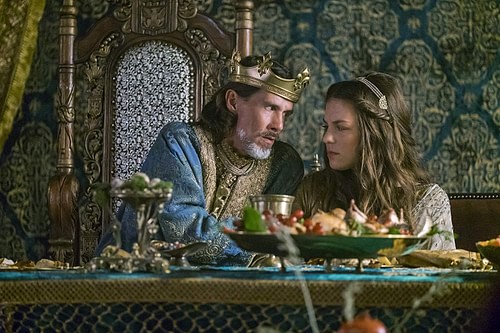
The series is accurate in its depiction of the defense of Paris, for the most part, although Charles' daughter Gisela of France was only a child or early teen when the treaty between her father and Rollo was concluded in 911 and so her character in the show is fictionalized. The series consistently draws on actual historical events and characters, weaving them into broader narratives, and one instance of this is when the Viking Siegfried is captured by Charles and ordered executed.
In the series, (Season 3:9) Siegfried, about to be beheaded in Charles' court, requests that someone hold his long hair away from his neck so the executioner will strike cleanly. When Charles agrees to this request, a guard leans forward and pulls Siegfried's hair forward, twining it around his fingers. As the blade comes down, Siegfried jerks back and the guard's hands are cut off. Siegfried then laughs loudly before Charles has him killed.
This incident is taken from the Icelandic Saga of the Jomsvikings (13th century) which relates the founding of Jomsborg off the Baltic coast of Poland (whose inhabitants were known as Jomsvikings). In the saga, a 17-year old Jomsviking, who has been taken prisoner and is to be executed, does exactly as Siegfried does in Vikings but is then set free by his captors for his cleverness, courage, and quick-wit.
Charles the Simple's depiction in Vikings is less than flattering for the most part as he is seen to rely first on Odo and then on Rollo to defend Paris and takes credit for their defense. The series is not meant to be historically accurate, of course, but to entertain and Charles' depiction works in the story arc and development of the characters.
It is unfortunate, however, that the wide audience the series enjoys will most likely take away a poor impression of the king who established the first positive and productive alliance between Viking raiders and the Kingdom of the Franks. As noted, earlier attempts to buy compliance from the Vikings only encouraged more raids in the region. Charles the Simple's approach was to include the Vikings in his kingdom and, in doing so, welcome them as equals instead of treating them as outsiders.
